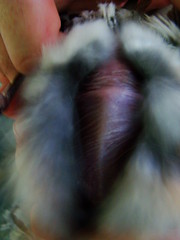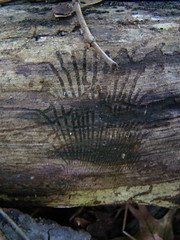A robin was extracted from the nets, but was not banded:

This is the leg of a robin infected with avian pox. As you can see, this leg ends in...mostly nothing.
Avian pox is caused by a virus that infects the mucus membranes, and featherless areas of the body (eyes, beak and feet). Transmission can be via mosquito bites and through direct contact with an infected bird. (This is NOT a disease that has been shown to affect humans).
There is no known treatment. Captive birds can be vaccinated with a live virus vaccine, but wild birds are on their own.

The disease had begun on the other leg, too. The skin of the right leg showed signs of skin breakdown and a few of the toenails have degraded.
This is also NOT avian conjunctivitis.
This robin was released without a band and we wished it well.
A band recovery:

For the life of me, I can't remember what kind of bird this was. (UPDATE: Female Wood Thrush)
Les can tell us. And he can also tell us if he got any info on when this bird was banded. (UPDATE: Last year)
Ever wonder what a brood patch looks like? Well, here ya go:

(Les is blowing the feathers while I shoot the photo)
Brood patches show up on birds during the breeding season. This featherless bit of skin is highly vascularized to transfer heat to incubated eggs. Most birds lose the feathers in this area automatically, but some species like ducks and geese, pull the feathers out themselves and line their nests with them.
As Les so eloquently put it, "It's like a coat with a zipper." :)
The position of the brood patch varies by species. Some species have a single patch, like the above bird, while others, like shorebirds, have a patch on either side of their belly.
Gulls and galliformes (game birds) can have three patches.
Gannets, pelicans and boobies (stop laughing) do not form brood patches, but cradle the eggs on their feet while incubating.
If the male and female of the species both share incubation duties, both of them can develop brood patches.
All that you ever wanted to know about brood patches, but were afraid to ask.
There is so much more in the woods than birds:

I seem to have gotten over my oogie-ness with holding bugs, I guess since Paco handed me a huge inchworm at Muddlety.
Even the evidence of long-ago bugs is cause to grab the camera:

Can't wait to get back out there....

9 comments:
What, no photos of Cloacal Protuberances? Afraid of that bird porn label?
Also ...
"You said boobies!" (laughing like a 12 year old boy)
~Kathi
From Les, though it escapes me why he can't just COMMENT: :)
"That bird that was already banded was my band. It was from last year and the bird is a female wood thrush. She has had a pretty amazing journey... she has flown back and forth across the gulf of Mexico quite a few times in her lifetime. She spends the winter in central America and then breed in Ohio."
Seeing the robin with avian pox makes me sad. Life isn't easy, is it.
That reminds me of graffiti I saw on a bathroom wall (and, yes, it was the women's bathroom).
In one handwriting: Life is a bitch.
Second handwriting: No, life is a virgin. If it was a bitch, it would be easy.
Susan, I never knew all that about brood patches. You have educated me once again. I feel so sorry for the robin. I hate disease!
You're way out of my league in bird-world, including photos, but I like learning something on blogs. Also, I've been meaning to thank you for that belly laughter in NJ last October. I just came across it a couple weeks ago, and what a lift!
Thanks too for your pic of Cooper's Hawk. They're much smaller than I'd realized. I had a large hawk in my suburban back yard about a year ago, probably interested in "my" sparrows, finches, etc. It was big --I think a Red Tail, but the tail striping was different from all the photo i.d.s I've seen on Red Tails.
Anyway, thanks for the humor and education. I'll drop in from time to time.
Banjo52.blogspot.com
I wonder if she gets to Brookville? I have seen some here but only one or two this summer.
I participated in my first bird banding at the local nature center last Sunday. We caught a female RBGB with a brood patch. It was so cool to see it for real and not just on someone's blog.
There's just so much neat stuff to learn in nature.
Just remembered I have a pic of a bird without a foot; maybe an Indigo Bunting? I will have to sort through my banding photos and put up a copy-cat post.
~K
I learned something today from you Susan... the brood patch. thank you!! I will have to do some looking on my own..google. haha
Post a Comment